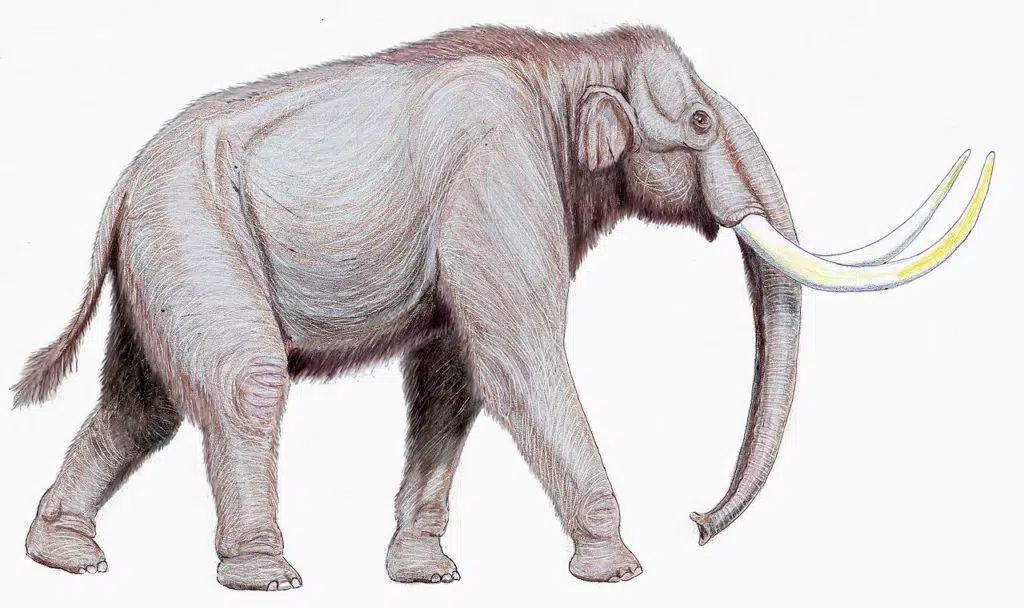
A 200,000-year-old “mammoth graveyard,” with an accompanying cache of tools made by Neanderthal people nearby, was unearthed this past week in Swindon in the United Kingdom.
Found in a quarry, the bones of five of the gigantic mammals, who were the ancestors of woolly mammoths, included those of an infant and two young mammoths along with those of two adults.
They died during the Ice Age that reigned during this period, at a time when Neanderthals thrived in what is now the UK.
The Last Glacial Period occurred from the end of the Eemian to the end of the Younger Dryas period, encompassing the time period from 115,000 to approximately 11,700 years ago, at the time that saw the rise of Homo sapiens and their gradual admixing with Neanderthals.
Neanderthal tools located nearby may have meant they hunted the gigantic mammals
Researchers stated that the stone tools they found at what is now a quarry had been created by Neanderthals. The implements include a hand ax and small flint tools known as scrapers, which were used to clean fresh animal hides.
DigVentures, a crowdsourced archaeological team from the U.K., led the excavations at the quarry.
At this point, the researchers state, they do not know if the mammoth bones have marks on them from the stone tools made by the Neanderthals; further research will be undertaken to see if this is the case.
Lisa Westcott Wilkins, the co-founder of DigVentures, said in a statement to the press “Finding mammoth bones is always extraordinary, but finding ones that are so old and well preserved, and in such close proximity to Neanderthal stone tools is exceptional.”
Incredibly, the hoard of mammoth bones and Neanderthal tools owe their discovery to two amateur fossil hunters, Sally and Neville Hollingworth, who uncovered them several years ago.
DigVentures then sponsored two field excavations in 2019 and 2020 to discover what further historical treasures the site might yield. The archaeologists indeed found more Ice Age relics there, including objects ranging from gigantic mammoth tusks and bones to delicate beetle wings and the fragile shells of freshwater snails.
Interestingly, the DigVentures archaeologists note that the five mammoths whose remains they uncovered were smaller than early Steppe mammoths, which commonly stood up to 13.1 feet (4 meters) tall at the shoulder. They state that this is most likely an indication that the species may have have become smaller due to the stresses of an especially cold time during that particular Ice Age.
Researchers state that the artifacts date back to between 220,000 and 210,000 years ago, toward the end of an interglacial, or relatively warm period, when Neanderthals still lived in Britain. They say that after temperatures dropped, Neanderthals abandoned the site, moving to the south.
Of course, the discoveries beg the question of whether or not the Neanderthals hunted the animals or just took advantage of coming upon them there or just scavenged their carcasses; the researchers will be attempting to determine this as time goes on.
As Live Science reports, evidence has been found previously of Neanderthals possibly stalking mammoths and other large pachyderms, including Neanderthal footprints that were found at a 100,000-year-old “nursery” for straight-tusked elephants (Palaeoloxodon antiquus) in southern Spain.
Duncan Wilson, the chief executive of Historic England, said in a statement on the find: “The findings have enormous value for understanding the human occupation of Britain, and the delicate environmental evidence recovered will also help us understand it in the context of past climate change.
“Through these finds and the research that will follow, we look forward to further light being shed on life in Britain 200,000 years ago.”
The dig was made possible by Historic England, Keith Wilkinson of ARCA at the University of Winchester, the site’s landowners, Hills Group Quarry Products and a team of specialists from several U.K. research institutions.
The incredible discovery will be shared with the world as part of a new documentary, called “Attenborough and the Mammoth Graveyard,” with Sir David Attenborough and Ben Garrod, an evolutionary biologist at the University of East Anglia. The show will air at 8 p.m. GMT on Thursday, December 30 on BBC One.
See all the latest news from Greece and the world at Greekreporter.com. Contact our newsroom to report an update or send your story, photos and videos. Follow GR on Google News and subscribe here to our daily email!



